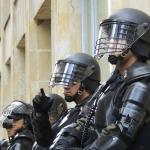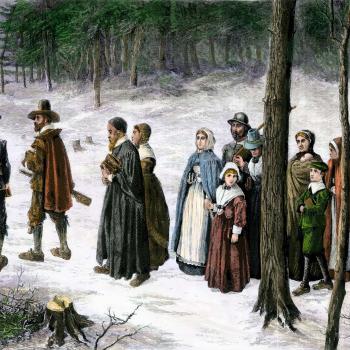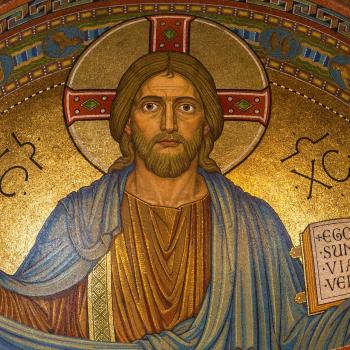Here’s the thing about Young Earth Creationists: they don’t stick to what the Bible says and leave it at that. Instead, they also look at mainstream scientific findings, and then they pick a piece here and a piece there and add all those pieces to what the Bible says, thus creating something new.
Take astroids setting off the flood, for instance. There is nothing at all in the Bible about astroids. This is somewhat of a problem, because the earth’s surface shows clear evidence of past massive astroid bombardment. Just look at the moon—that pock-marked scaring didn’t happen recently. There was a period in the earth’s past when there were massive meteor bombardments.
How do you fit past meteor activity into a Young Earth Creationist timeline? If God created the earth and everything in it in a week just six thousand years ago, where did all of those astroid strikes come from? Answers in Genesis has, well, answers:
The cratering patterns observed on the moon were formed during two distinct impacting episodes. The abundant small craters on the lunar highland surfaces were caused by meteor impacts around the time of the Fall or perhaps during Creation Week itself. The large impact basins and resultant maria were formed at the time of the Flood by a narrow, intense, swarm of meteoroids travelling on parallel paths.
I don’t know about you, but I don’t remember seeing that in the Bible. It’s also oddly specific. The large craters on the moon were created a swarm of meteoroids that hit during Noah’s flood why exactly? What is it about a global flood that is connected with meteors?
Oh wait—this may be why:
[I]t should be remembered that asteroid/meteor impacts are not foreign to Flood geology models. A meteor impact or impacts may have been the catalyst which triggered the fountains of the great deep to be broken up (Genesis 7:11). Once this occurred, the catastrophic movement of the tectonic plates which resulted from that breakup would have triggered in turn the release of huge quantities of molten rock onto the ocean floor and on land. Increased volcanism is a natural consequence of this continental breakup event, as molten rock (magma) from the upper mantle rises into the huge rifts in the crust. This volcanism associated with Catastrophic Plate Tectonics (CPT) would have been of unprecedented magnitude and worldwide extent. At the plate boundaries, the magma rapidly rising into the fissures would push the plates apart, so that their separation accelerated to meters (tens of feet) per second. The net result would have been violent volcanic eruptive events on a massive global scale.
First of all, everybody would have died. Try imagining this for a moment. To start with, we have meteors large enough to literally fracture the earth’s crust. Then we have massive quantities of molten rock spew up from these fissures as the earth’s crust splinters. There would be lots and lots of gas, much of it poisonous. And somehow, at the same time, we have catastrophic levels of (acid) rain and a global flood that covers the entire earth. Everybody would have died.
I’m reminded of N. K. Jemisin’s The Fifth Season. In it, massive volcanic and tectonic events create a “fifth season” every few hundred years, a years-long or decades-long event during which the sun is blotted out, ash falls from the sky, poisonous gasses kill tens of thousands of people, acid rain rains down destruction, vegetation dies, and so forth. People hunker down in walled compounds with their food stores to wait it out. Most of them don’t make it.
I mean good gracious, a single volcanic reputation in Tanbora in 1815 led to the “year without a summer” as crops died due to lack of adequate sun and snow fell in July. And yet somehow we’re supposed to believe that the earth was rocked by “violent volcanic eruptive events on a massive global scale,” and yet Noah and his family were able to leave the ark after a year and just start their lives. Somehow the sun was not blotted out, the air was clear, the weather worked.
Second, can you guess what isn’t mentioned in the story of Noah’s flood? Volcanos. In fact,the Bible doesn’t really mention volcanos at all. Have a look at this collection of verses to see how hard those creating concordances have to stretch to make any verse sound even remotely volcano-related. (The Bible doesn’t say much—if anything—about meteors either.)
Which is more likely: that Noah’s Flood included a massive meteor storm and worldwide volcanic eruptions and these things were left out of the story; or that meteors and volcanos were not part of the lived experience of the society within which the story of Noah’s Flood was created.
And yet somehow we get Answers in Genesis articles like this:
Have you ever wondered what triggered the Genesis Flood? Genesis 7:11 tells us that a unique geologic event took place at the same moment as the Flood began: “In the six hundredth year of Noah’s life, in the second month, the seventeenth day of the month, on that day all the fountains of the great deep were broken up, and the windows of heaven were opened.”
Most creation geologists believe that the opening of “the fountains of the great deep” refers to the breakup of the earth’s crust into plates. The subsequent rapid, catastrophic movement of these plates would have released huge quantities of hot subterranean waters and molten rock into the ocean. As the hot water gushed through the fractured seafloor, the water flashed into superheated steam and shot high into the atmosphere as supersonic steam jets, carrying sea water that eventually fell as rain.
But what catastrophe might God have used to cause the earth’s crust—many miles thick—to crack? Some have suggested a meteorite or asteroid impact of unprecedented size and scope. Do we find any evidence? Geologists have discovered some gargantuous remnant craters and piles of debris, leftover from massive impacts that easily fit the bill.
I am again reminded of The Fifth Season.
Interestingly, I found an article by two scientists who believe a massive astroid may have set plate tectonics in motion toward the end of the Late Heavy Bombardment.
Earth was still a violent place shortly after [bacterial] life began, with regular impactors arriving from space. For the first time, scientists have modelled the effects of one such violent event – the strike of a giant asteroid. The effects were so catastrophic that, along with the large earthquakes and tsunamis it created, this asteroid may have also set continents into motion.
The asteroid to blame for this event would have been at least 37km in diameter, which is roughly four times the size of the asteroid that is alleged to have caused the death of dinosaurs. It would have hit the surface of the Earth at the speed of about 72,000kmph and created a 500km-wide crater.
At the time of the event, about 3.26 billion years ago, such an impact would have caused 10.8 magnitude earthquakes – roughly 100 times the size of the 2011 Japanese earthquake, which is among the biggest in recent history. The impact would have thrown vapourised rock into the atmosphere, which would have encircled the globe before condensing and falling back to the surface. During the debris re-entry, the temperature of the atmosphere would have increased and the heat wave would have caused the upper oceans to boil.
I’m pretty sure humans couldn’t survive a heatwave that caused the upper oceans to boil—even if they were inside an ark. Also, this definitely isn’t mentioned in Genesis.
Research and models based on the astroid that killed the dinosaurs is also of interest.
Researchers say they’ve used a world-class computer model to learn that Earth was plunged into darkness for nearly two years, following an asteroid impact 66 million years ago, at the end of Earth’s Cretaceous Period.
…
Scientists also calculate that the force of the impact would have launched vaporized rock high above Earth’s surface, where it would have condensed into small particles known as spherules. As the spherules fell back to Earth, they would have been heated by friction to temperatures high enough to spark global fires and broil Earth’s surface. A thin layer of spherules can be found worldwide in the geologic record.
Genesis does not mention meteors or volcanos or darkness. In fact, the Genesis account of Noah’s Flood speaks of rain that continued for “forty days and forty nights”—suggesting that there was still light—and when the floodwaters begin to recede after a year, Noah sends out a dove, which returns with a newly grown leaf; he takes this as a sign that it is safe to leave the ark. Yet according to the scientific model discussed above, after an astroid strike such as the one that killed the dinosaurs, photosynthesis would not have been possible for up to two years.
Feel free to reread the Genesis Flood account. It’s tells the story of a massive flood, not a global catastrophe characterized by meteors and volcanos. But Young Earth Creationists don’t seem to be so bothered by prohibitions against adding things to the Bible.
I have a Patreon! Please support my writing!















